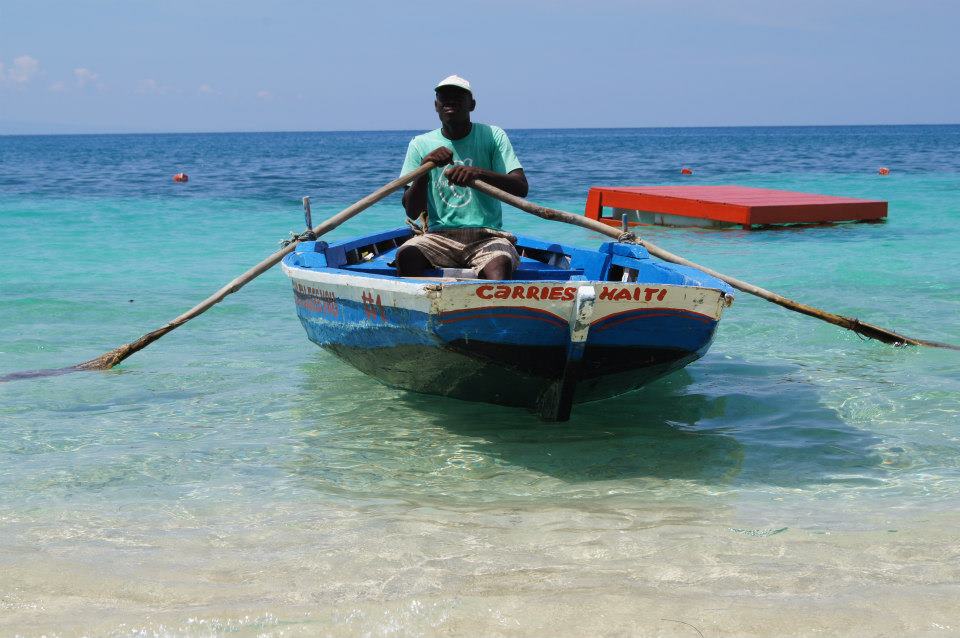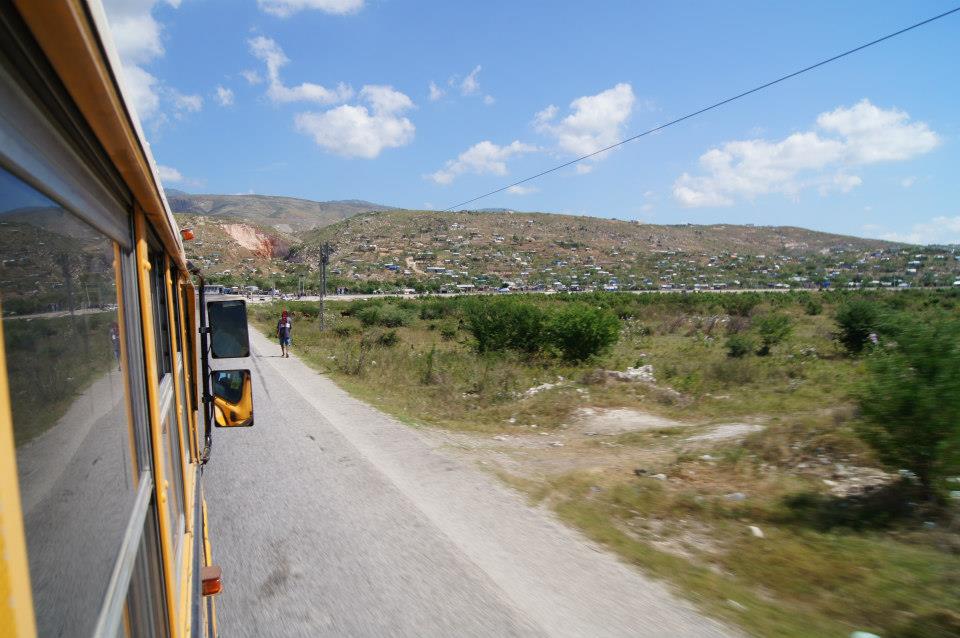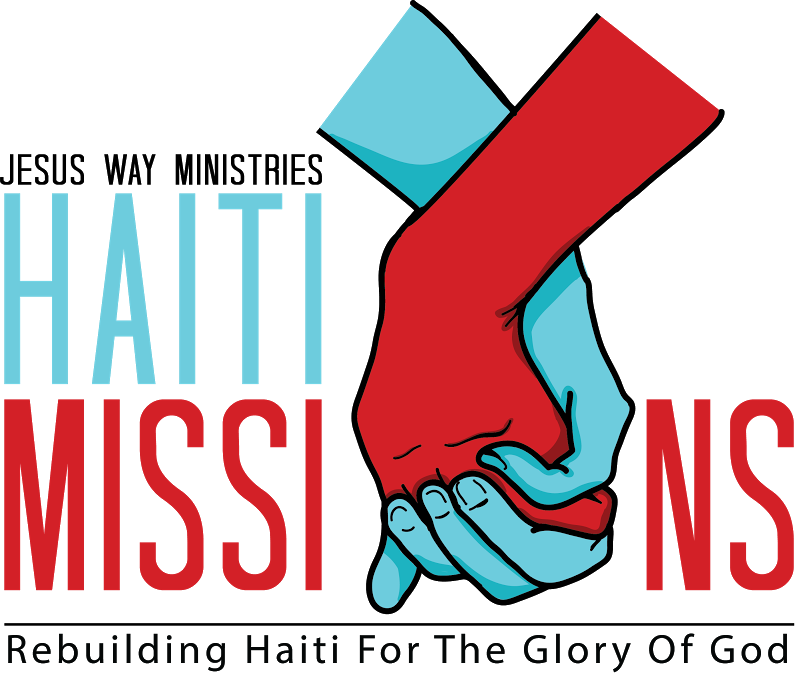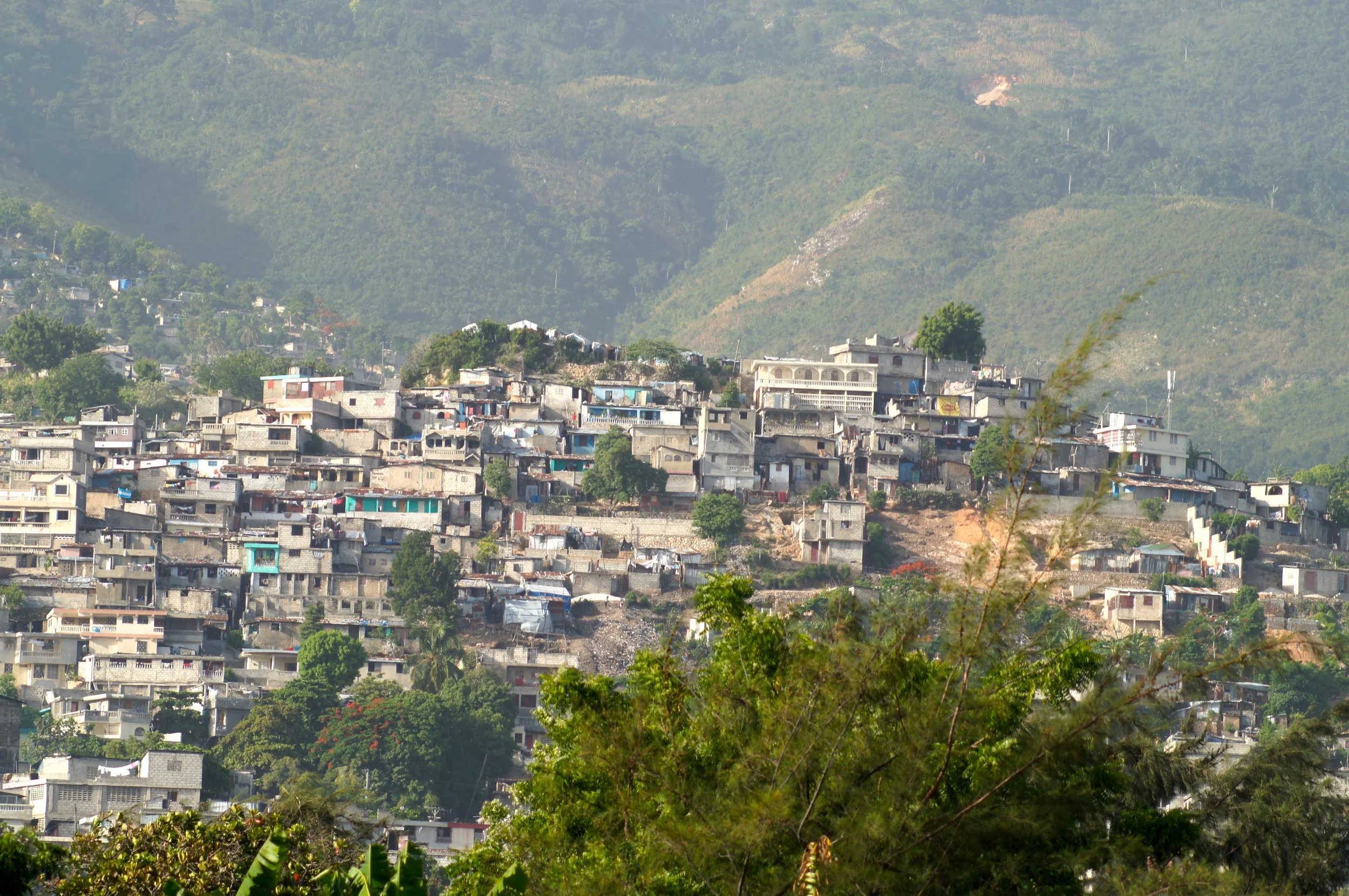The unique nation of Haiti
By Gabby Hunsucker
How can a country so rich in culture be so poverty stricken? The nation of Haiti has been shaped by its geographical location, history, culture, and religions. Throughout its past struggles, Haiti has evolved into the unique place it is today.
Geography
Haiti’s distinct geography has played a key role in the development of this small country. Located in the Western Hemisphere, Haiti shares the island of Hispaniola, the second largest island in the Caribbean, with the Dominican Republic. Positioned in the Caribbean Sea, Haiti occupies approximately one-third of the island and is about the size of Maryland. This nation is made up of plateaus, planes, and valleys, with two-thirds of its land being mountainous, making it hard to cultivate. In fact, the name Haiti means “mountainous country.” Haiti’s highest peak is Morne de Selle, at 8,793 feet above sea level. The mountains are barren, causing top soil to wash away during torrential downpours, eventually leading to problems with erosions. Haiti’s northern region has many streams and rivers. However during the dry seasons, they slow to only a trickle, but during the rainy seasons, they often become extremely powerful, overflowing, causing major flooding throughout the region. The country has a tectonic fault line running through it, which can cause sporadic earthquakes. Haiti is also plagued with frequent hurricanes, adding to its already adverse geography.
history
Just as geography has played an important role in the development of Haiti, its history has also been very influential. Hispaniola was discovered by Christopher Columbus in 1492. Within a period of about 25 years, the Taino Indians, who were native to the island, were obliterated by the Spanish settlers. Around the beginning of the seventeenth century, the French began to inhabit the western third of this land. By 1697, Spain ceded that portion of Hispaniola to France. This part of the island which later became known as Haiti, was one of the richest colonies in the Caribbean during the 1700s. This wealth was mostly due to forestry and sugar industries. Mohogany trees were cut for raw material, which left the land very barren; trees were not replaced, endangering the region with vulnerability to erosion. During this time period, African slaves were imported to work on coffee and sugarcane plantations. In 1697, this French colony, known as Saint Dominique, became a leading producer of sugarcane. Because of this, it was called the “Pearl of the Antilles."
As the 18th century came to an end, this region had about 500,000 slaves. With the increasing slave population, they began to rebel, and in 1791, a revolt broke out. These suppressed plantation workers gained control of the northern portion of the French colony. In 1804, the local people established independence from France. At this time they named the colony Haiti. This newly founded nation became the world’s oldest black republic. In 1822, Haiti took over the eastern Spanish-speaking area of Hispaniola, known as Santo Domingo. Twenty-two years later, Santo Domingo separated from Haiti to become the Dominican Republic. Haiti had many periods of economic and political unrest because of 22 changes in government between the years of 1843 and 1915. Finally, in 1915, the United States of America intervened militarily. They occupied Haiti for nineteen years, but withdrew in 1934, leaving Haiti with sovereign rule. During this occupation there were several improvements made to the nation. Yellow fever, a deadly disease, was eliminated. Schools, hospitals, and roads were built, although the roads all lead to the country’s capital, Port-Au-Prince. This left much of the country in isolation, which is still the case today.
Finally, in 1957, after the first successful election, a black country doctor became president. Unfortunately, Francois “Papa Doc” Duvalier became a brutal and ruthless dictator over this nation. After being president for seven years, “Papa Doc” declared himself president for life. His reign was consumed with violence and terror. During his years in office, the majority of Haiti’s doctors, teachers, and other professionals left the country to escape this harsh dictatorship. “Papa Doc” used foreign aid and funds from the treasury for his own personal use. He was a voodoo priest and even encouraged the practice of voodoo during his reign. This evil ruler made up his own laws and appointed many of his friends and family members to prestigious jobs in the government. “Papa Doc” always dressed in black and wore a black hat. Many people referred to him as the personification of the god of the dead. Several unsuccessful attempts were made to remove Duvalier from power. He governed Haiti until 1971, when he died.
Unfortunately, conditions continued to deteriorate when the son of “Papa Doc,” Jean Claude, became his successor at the young age of nineteen. Following in his father’s footsteps, Jean Claude also declared himself president for life. “Baby Doc,” as he was nicknamed, ruled by brutal repression and also used Haiti’s national treasury for his own personal spending. Finally, in 1986, he was overthrown from power by mass protestors, and once again, the United States sent its military to take charge.
Throughout the next twenty plus years, Haiti experienced several different leaders. After four years of military rule, a Roman Catholic priest, Jean-Bertrand Aristide, was elected president in 1990. This was the first democratic election held in Haiti in decades. During his reign, violence spread, and drug trafficking and poverty worsened because of his poor leadership. In 2004, opposition to this leader increased and riots broke out, causing Aristide to flee the country. The United Nations sent peace keeping troops into Haiti to try to calm the rebellion. They oversaw a new election in 2006, when René Prévail was chosen as the new president. This democratic process was a crucial step in bringing stability to Haiti. Prévail was the former prime minister and was very popular among the poor. In 2011, after a very long and drawn out, controversial, electoral process, Michel “Sweet Micky” Martelly was selected as the new leader of Haiti. Martelly is a popular musician in Haiti, as well as their current president.
As important as geography and history have been to the shaping of Haiti, the culture has impacted the country just as strongly. There has always been a major division of classes in Haiti between the rich and the poor. There is no middle class; the Haitian people either live in poverty or are wealthy and hire the disadvantaged to work for them as servants. It is widely accepted for the men of Haiti to maintain more than one conjugal relationship outside of marriage, while being legally married. These women are often friends and have no problem with the arrangement. Nearly 10% of Haitian men have more than one “wife.” These relationships are looked at as justifiable in the community. It is the only lifestyle many of them know. It is not uncommon for a man to live with a woman many years out of wedlock, to have children together, and to consider themselves married. Because of these lifestyles many children are born out of wedlock, grow up without any parental supervision, and therefore, the cycle of adultery and fornication continues repeating itself.
language
Another aspect of the culture in Haiti is the language. Haitian Creole is the most common means of communication in this country. This language is a mixture of French, African, Spanish, and English. However, the well-educated, elite social class of Haiti speaks fluent French, and sometimes English as well. The language barrier aids in widening the division between the wealthy and the poor. Although the number of Haitians in the lower classes greatly outnumber the influential Haitians, the few rich have much more power than the masses. The government official and the judicial system operate solely in French, which alienates the citizens who only speak Creole. This excludes them, leaving complete control to the upper class.
Education
An additional key factor in the culture of Haiti is its lack of education. The deficient academic progress in this nation mirrors the extreme struggle with poverty that this country faces. Public education is free; however, it is widely unavailable. Only a small percentage of Haitians are educated. Many are illiterate; only 53% of Haitians can read. Many children have never attended school, but rather learn the trade of their parents. In Haiti, private schools are the main source for education and make up about 75% of all educational programs. Churches run the majority of schools in Haiti. Most of Haitian families cannot afford to pay for their children to attend these private schools, so the they usually remain at home and help their parents, trying to earn a living. The number of Haitians that attend a university is extremely small. There are only 18 universities in Haiti, the majority of which are located in Port-Au-Prince. Most school curriculum is written in French, which makes it mandatory for the children to become fluent in this language in order for them to succeed. French is thought of as the language for the more educated Haitians, whereas Haitian Creole is known as the language of the poor whom are never able to pursue education.
Culture
Another thing that shows Haiti’s vibrant culture is their creativity of transportation. In the midst of this poverty, they have created a way to express their uniqueness in tap-taps. “Tap-taps” can be busses, trucks, motorcycles, or even scooters, that are decorated in bright, expressive colors and used to provide transportation from place to place. They have everything from religious figures, celebrities, singers, political figures, and words painted on them. They are very artistic and truly show how inventive the Haitian people are.




Additionally, Haiti is a cultural country of artists, rich in beauty, sound, and color. The creativity of Haitian art is the most unique and outstanding in the Caribbean. The streets of Haiti are colored with artwork, from painted advertisements on buildings and fences, to the festively decorated tap-taps. There are a few galleries and museums in Haiti, displaying much of the local artists’ work. Also, many artists display their art in the most unusual manner on a street named the Grand Rue. Showcased in cinderblock houses, these sculptors turn scrap metal, wood, steel drums, iron, plastic, and even car parts into other unusual works of art. The artwork in Haiti is bold and bright. It usually depicts a Christian theme or voodoo spirits, or may even combine the two. The art scenes of Haiti are steeped rich in tradition.
Two other important elements of Haitian culture are music and dance. These are used to accompany voodoo ceremonies, and sometimes in resisting certain political forces. They are also used for entertainment. Music has played an important role in the development of Haiti. One of the most popular is “rara.” When carnival, a festive celebration, is held in Port-Au-Prince and Jacmel, the towns are filled with people who come to hear rara bands parading down the streets. The bands compete for a prize, as they march for miles through the more rural areas, playing bamboo and zinc trumpets. Another popular type of music in Haiti is raciness, which came from the voodoo-jazz movement of the 1970s. Several Haitians have signed recording contracts and have become famous at home and also oversees. The current president of the country, Michel Martelly, is also a rising star who has released two popular albums. Haiti has produced singers and songwriters with amazing creativity and talent.
Haiti’s cuisine is another cultural characteristic of this nation that makes it unique. Its rich and flavorful food truly shows the mixture of the culture. In this country, food is usually cooked and eaten outside. Haitian food is a combination of a variety of nations’ culinary traditions. It is mainly derived from the French, United States of America, Spain, and Africa. Haiti cuisine is Cajun and has incredible, peppery flavor. It is very similar to other Caribbean food, but it is spicier. Since Haiti has easy access to seafood, it is often times included in the meal. Chicken, goat, and pork are the most common meats in Haiti. However, a lot of Haitians cannot afford much more than rice and beans. They usually try to spice the food up with whatever they have in the kitchen.
Yet another interesting aspect of Haiti’s culture can be found in their creativity and hard work, trying to find the means to survive. Since much trading and selling occurs in the cities, a large number of Haitians have moved from country sides to these areas. They struggle to provide enough money to afford sufficient food for their families. An estimated 80% of these people live in poverty. The majority do not have access to clean water, which contributes to the many health problems that a lot of Haitians face today. Many live in the city rely on the rainwater from gutters for drinking water. Most of these people do not have access to electricity, and even the ones who do, have it sporadically. Those who live in the city tolerate conditions that those who live in the country do not have to worry about. The extremely poverty stricken Haitians usually live in neighborhoods on the outskirts of the cities called slums. Whenever it rains, and the roads begin to flood, the sewage, debris, and trash wash into these areas. This results in outbreaks in cholera, along with many other diseases. Pollution is another problem for those who live in the overpopulated towns. Often times, it is violent and desolate in these places. The conditions in these neighborhoods are extremely unsanitary, which leading to many diseases. Many Haitians who live in rural areas struggle as farmers that travel each day to sell their goods in town. Some of these people walk for hours, while carrying their fruits and vegetables in baskets on their heads, to sell their produce at the market.
Religion
The nation of Haiti has been greatly affected by its religious beliefs. An estimated 80% of Haitians are Catholic, 20% are Protestant, but over half of these people still practice voodoo. One of the first Protestant groups to make an impact in Haiti was the Baptist denomination. This group has grown and spread rapidly throughout Haiti. Evangelical Protestants teach the Bible as the final authority, admittedly condemning voodoo, even considering it demonic. They regard it as superstition controlled by the devil. The term voodoo means “spirit.” Many Haitians have combined Catholicism with their voodoo beliefs because they still believe that the spirits “lwa” are important. A large number of Haitians believe that these spirits are inferior gods who provide a line of communication with the one superior God. They feel that the one true God is too distant and important to be communicated with directly. The main sources of communication with the “lwa” are through dance and music.
This belief was brought over to Haiti by the African slaves. As plantation workers, many were required to accept and practice the religion of their master, so therefore many Haitians started practicing Catholicism. However, the slaves did not stop practicing their own beliefs; they just adopted more. This was the start of the mix of Catholicism and voodoo that is vivid in Haiti to this day. This nation is the voodoo capital of the world. Haitians call upon these spirits to improve harvests, cure diseases, seal contracts and marriages, and help make important decisions. Politics are also greatly affected by voodoo; in fact, in 2003, President Jean Bertrand Aristide officially approved this practice as a legitimate religion. This allows Haitians to openly perform voodoo with legal authority. Practitioners of this belief usually offer animal sacrifices. Usually the throat of a small animal, like a chicken or a lamb, will be cut and some of the blood is used in the ceremony. Afterwards, the animal is cooked and eaten so there is no waste. Many believe the “lwa” are deceased ancestors who protect them from misfortune. Because of this, they “feed” this spirit during rituals. There are voodoo priest and temples where ceremonies can be performed. During these events, there is first a feast, then a rattle is shaken, drums are played, and there is dancing and chanting. The priest “communicates” with the “lwa.” If the spirits become unhappy, many Haitians believe that they can make people sick. Therefore, rituals are used to treat sicknesses. These people believe that they must decorate tombs, have intricate funerals and hold mourning rituals to help keep the spirits happy. In Haiti, voodoo impacts everyday life, regardless of the person’s religious affiliation.
Natural DISASTERS
Among the many catastrophes that Haiti has had to endure, the greatest occurred on Tuesday, January 12, 2010, when this nation experienced a massive earthquake. It measured 7.0 on the Richter scale. This earthquake dealt a blow as great as the force of several nuclear bombs. It lasted only about thirty-five seconds, but in that amount of time it flattened most of the buildings in Port-Au-Prince. The capital city of Haiti was demolished and 230,000 were killed. About 300,000 people were injured and 2.3 million people had their homes destroyed or vacating the area. Over 180,000 buildings crumbled due to this earthquake. Over 80% of schools in the area of the earthquake and over half of the hospitals were gone. Almost one-fifth of the federal employees died and 60% of the government buildings were destroyed. The Palais National, Haiti’s capital, was completely demolished. The Supreme Court, the central prison, the two cathedrals in Port-Au-Prince, and the United Nations headquarters fell to the ground. What was already the poorest country in the Americas, experienced one of the world’s largest national disasters. The airport was damaged, so it took days to reopen, causing delays in the delivery of supplies. It took almost two weeks to get the port reopened. The United States army initiated the emergency response. There was an enormous humanitarian outpouring from around the world. The United Nations coordinated health, water sanitation, and hygiene protection for all the tent cities that sprang up. About 1.5 million Haitians were forced to relocate to tents.
One year later, less than ten percent of the debris was cleared. Around 800,000 people were still living in tents. Only one-fourth of these people had proper sanitation or access to clean water. There were concerns over flooding during hurricane season and disease outbreaks, such as cholera and malaria, were anticipated. Security was also a problem with an epidemic of rape. Haiti’s infrastructure was in dreadful condition before the earthquake; but the people hoped to build it back better and stronger.
Haiti today
Still today, there are many groups offering humanitarian aid to Haiti, but the disaster has been overwhelming. This nation will be rebuilt only when the Haitians take the lead, as they did after thirteen years of revolutionary war, when they gained their independence. Through many hardships, Haiti has continued to persevere. Although it seems dauntless, the Haitian people’s persistence and dedication will once again pull them through.
As the 18th century came to an end, this region had about 500,000 slaves. With the increasing slave population, they began to rebel, and in 1791, a revolt broke out. These suppressed plantation workers gained control of the northern portion of the French colony. In 1804, the local people established independence from France. At this time they named the colony Haiti. This newly founded nation became the world’s oldest black republic. In 1822, Haiti took over the eastern Spanish-speaking area of Hispaniola, known as Santo Domingo. Twenty-two years later, Santo Domingo separated from Haiti to become the Dominican Republic. Haiti had many periods of economic and political unrest because of 22 changes in government between the years of 1843 and 1915. Finally, in 1915, the United States of America intervened militarily. They occupied Haiti for nineteen years, but withdrew in 1934, leaving Haiti with sovereign rule. During this occupation there were several improvements made to the nation. Yellow fever, a deadly disease, was eliminated. Schools, hospitals, and roads were built, although the roads all lead to the country’s capital, Port-Au-Prince. This left much of the country in isolation, which is still the case today.
Finally, in 1957, after the first successful election, a black country doctor became president. Unfortunately, Francois “Papa Doc” Duvalier became a brutal and ruthless dictator over this nation. After being president for seven years, “Papa Doc” declared himself president for life. His reign was consumed with violence and terror. During his years in office, the majority of Haiti’s doctors, teachers, and other professionals left the country to escape this harsh dictatorship. “Papa Doc” used foreign aid and funds from the treasury for his own personal use. He was a voodoo priest and even encouraged the practice of voodoo during his reign. This evil ruler made up his own laws and appointed many of his friends and family members to prestigious jobs in the government. “Papa Doc” always dressed in black and wore a black hat. Many people referred to him as the personification of the god of the dead. Several unsuccessful attempts were made to remove Duvalier from power. He governed Haiti until 1971, when he died.
Unfortunately, conditions continued to deteriorate when the son of “Papa Doc,” Jean Claude, became his successor at the young age of nineteen. Following in his father’s footsteps, Jean Claude also declared himself president for life. “Baby Doc,” as he was nicknamed, ruled by brutal repression and also used Haiti’s national treasury for his own personal spending. Finally, in 1986, he was overthrown from power by mass protestors, and once again, the United States sent its military to take charge.
Throughout the next twenty plus years, Haiti experienced several different leaders. After four years of military rule, a Roman Catholic priest, Jean-Bertrand Aristide, was elected president in 1990. This was the first democratic election held in Haiti in decades. During his reign, violence spread, and drug trafficking and poverty worsened because of his poor leadership. In 2004, opposition to this leader increased and riots broke out, causing Aristide to flee the country. The United Nations sent peace keeping troops into Haiti to try to calm the rebellion. They oversaw a new election in 2006, when René Prévail was chosen as the new president. This democratic process was a crucial step in bringing stability to Haiti. Prévail was the former prime minister and was very popular among the poor. In 2011, after a very long and drawn out, controversial, electoral process, Michel “Sweet Micky” Martelly was selected as the new leader of Haiti. Martelly is a popular musician in Haiti, as well as their current president.
As important as geography and history have been to the shaping of Haiti, the culture has impacted the country just as strongly. There has always been a major division of classes in Haiti between the rich and the poor. There is no middle class; the Haitian people either live in poverty or are wealthy and hire the disadvantaged to work for them as servants. It is widely accepted for the men of Haiti to maintain more than one conjugal relationship outside of marriage, while being legally married. These women are often friends and have no problem with the arrangement. Nearly 10% of Haitian men have more than one “wife.” These relationships are looked at as justifiable in the community. It is the only lifestyle many of them know. It is not uncommon for a man to live with a woman many years out of wedlock, to have children together, and to consider themselves married. Because of these lifestyles many children are born out of wedlock, grow up without any parental supervision, and therefore, the cycle of adultery and fornication continues repeating itself.








